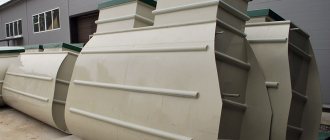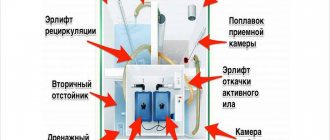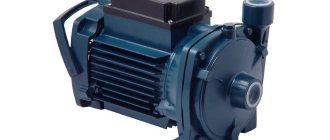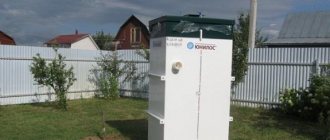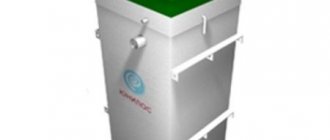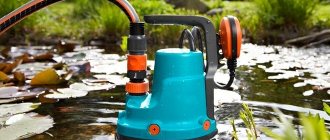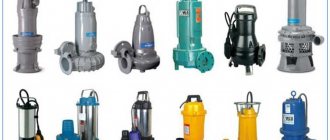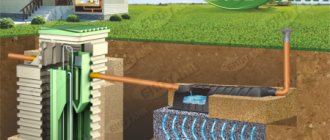Purpose of units
Disinfection and disinfection of the contents of cesspools is carried out with active substances. Their danger to the environment and humans has been proven. Therefore, sensible owners are moving to a safe biological method of combating pollution using colonies of living bacteria. Feeding on organic matter from household and household waste, bacteria break it down into water, carbon dioxide and safe sludge.
Biological products for septic tanks contain one of two types of microbes - anaerobic, aerobic, or a combination of both (used in the simplest single-chamber structures). Heavy solid waste settles in the first chamber. They are carried out by anaerobic microorganisms that can survive without oxygen and decompose (oxidize) wastewater into low molecular weight compounds. Cleaner wastewater with small particles ends up in the second and third tanks of the septic tank. Aerobic bacteria are used for their processing, the vital activity of which is impossible without access to molecular oxygen. The activity of microorganisms increases with increasing volume of supply air.
Compressors for autonomous septic tanks connected to aerators are necessary for uninterrupted pumping of oxygen through the volume of waste liquid with aerobic microflora. This is an electrical device for moving gaseous mixtures - it pumps air into the aerator. The latter is a perforated pipe or hose that is laid at the bottom of the tank. Through the holes in the pipe, the supplied air escapes from the aerator and moves upward. Along the way through the thickness of the liquid, part of the oxygen dissolves in it and ensures the vital activity of microorganisms.
Aerator for septic tank
For a country house, the efficient functioning of the wastewater system is very important. A sump tank is used to clean wastewater from private houses.
The best option is to use a sump with a forced aeration function. For this device to work, you will need a special device - an aerator.
Purpose
Why is it needed? To do this, we will consider the processes of purification of drainage masses in the sump structure. A septic tank can have one, two or three compartments.
The operating principle of all sedimentation tanks is similar. In fact, everything is represented by an ordinary sealed container with the cleaning processes of the drainage masses occurring inside. Contaminated liquid from your home is pumped into it, processed and initially purified.
A septic tank made of concrete rings can also vary in size. So, one- and two-chamber septic tanks hold different volumes of wastewater. Whatever design is used, the purification property of the septic tank lies in the internal process that occurs, because of which the wastewater is purified.
Bacteria living in the sump trap the pollutants. Thus, due to the activity of microorganisms, biological purification takes place. Microorganisms decompose organic matter into liquid and insoluble sediment - silt. As a result, all harmful elements fall to the bottom of the sump.
These devices contain 2 types of bacteria - aerobic, which require oxygen to maintain life, and anaerobic, which do not need it.
Ventilation of the sump is necessary because these bacteria produce toxic gases.
The settling tank must have a ventilation system, since anaerobic bacteria release ha and, as a result, an unpleasant odor.
Conventional energy-dependent installations are designed in such a way that cleaning processes occur due to anaerobic microorganisms. But they do not completely decompose organic matter, and they also act rather slowly.
For better wastewater treatment, a biological treatment method is used, which occurs using forced aeration. Aeration is the forced supply of oxygen under pressure. Aerobic installations of new production already have an aerator. If you have a simple sump built a long time ago, then it can be improved by using additional equipment.
Simple settling tanks are equipped with vent pipes to allow gases from decomposed organic compounds to escape. But this type of system will not be able to create the volume of air you need in the tank.
The normal operation of a septic tank depends, in addition to ventilation, also on oxygen saturation. And if your task is to benefit the sump, then you need to provide properly functioning aeration and ventilation to remove toxic gases retained in it.
Therefore, a ventilation pipe is built into the septic tank, the function of which is to remove these gases using pressure. An important point is that the pipe must be at least half a meter above the ground. This helps to remove all toxic elements that cause harm and clog the sump.
And to do the job you will need an aerator. This device is installed on the bottom of the container, provides internal ventilation and, accordingly, air ingress. The treated oxygen is removed through the normal ventilation system.
Principle of operation
The aeration element in the sewer system serves as a distributor of air masses. Better wastewater treatment occurs due to fine aeration. This is when oxygen enters liquid masses in small bubbles.
The principle of operation is that the aerator has many tiny holes through which oxygen passes, supplied by the compressor. Oxygen passes through the aerator and forms many bubbles that are distributed throughout the liquid. The environment is saturated with air due to the fact that, according to the law of physics, oxygen bubbles tend upward, and a cleansing process occurs.
The active biological mass is mixed with contaminated water, which ensures complete water purification. During the cleaning process, no unpleasant-smelling gases are released and the operation of the septic tank does not create uncomfortable conditions for residents.
A septic tank can also have intermittent aeration. But you need to take into account the nuance that at the moment when air does not flow, the holes must be in the closed position, otherwise silt particles may enter the device.
Types and characteristics of used superchargers
The work process of compressing and moving air is ensured by periodically changing the internal volume of the device chamber. The principle of oxygen injection is decisive when dividing compressors into types.
Screw
The working pair consists of two rotors with multidirectional profiles of their surfaces, reminiscent of a meat grinder screw.
The meshing rotors rotate in a sealed chamber and compress the incoming air by sealing the gaps between the housing and the screw pair. Then the exhaust valve opens, and air is briefly released to the compressor outlet. The valve setting, the frequency of the profile turns and the area of the teeth determine the frequency of air release and the magnitude of its pressure.
Advantages of screw structures:
- Durability of working screws made of high-strength steel.
- Economical energy consumption.
- Work with minimal vibration.
- Small dimensions.
- Good controllability of automatic systems.
Classification of drain compressors
When choosing a compressor for a septic tank, it is necessary to take into account the volume of the chamber for which the device is intended. The larger the capacity of the tank, the more powerful the compressor will be required. The exact relationship between these two factors is shown in the table.
Dependence of the volume of the septic tank on the power of the compressor:
| Septic tank volume | Compressor characteristics |
| 2 – 3 meters 3 | 60 liters per minute |
| 3 – 6 meters3 | 80 liters per minute |
| 6 – 8 meters 3 | 120 liters per minute |
| 8 – 10 meters 3 | 150 liters per minute |
The greater the productivity of the septic tank, the more electricity it consumes. It is not advisable to select a powerful compressor for a small septic tank, since it will not give the best results, but will increase energy costs. The opposite is also true - a low-power compressor for a large-volume septic tank will not provide complete wastewater treatment.
What to consider when choosing
The effective operation of colonies of aerobic microorganisms depends on their stable supply of oxygen in the required quantities. Therefore, the main selection criteria are performance and pressure generated by the device.
The amount of pressure determines whether the air in the aerator can overcome the resistance of the liquid column and rise to the surface. The deeper the sump tank, the greater the outlet pressure the device must create. Most septic tanks have a depth of up to 2 m. They are equipped with compressors with a pressure range of 2-2.5 atm.
Productivity - the volume of air pumped per unit of time - depends on the power of the device. It becomes a determining factor in the productive treatment of wastewater by bacteria.
Remember! The active life of aerobic microorganisms is equally adversely affected by a lack and excess of oxygen concentration in water.
The volume of the tanks (with the exception of the volume of the first chamber with heavy waste, which contains anaerobic microorganisms) affects the required productivity of the device. For example, for containers of 2-3 m3 and 4 m3, blowers with a capacity of 60 l/min and 80 l/min, respectively, are suitable. The use of a more productive model will require the introduction of automation into the operating circuit to periodically stop the air injection process. This mode will reduce the durability of the device.
More information about what type of unit to purchase
When choosing a compressor for a septic tank, you should know that these units are necessary to increase gas pressure, which occurs by reducing its volume. Installations operating on this principle can be screw or piston. They differ from each other in the principle of gas injection inside.
For example, piston engines provide pressure through the movement of pistons; As for the screw ones, they work due to the block with the corresponding name. Some believe that it is worth choosing the second type, because such devices are more compact, durable and have a low level of vibration.
Looking at piston devices in more detail, you can highlight one of their varieties - an electromagnetic membrane compressor for a septic tank. Such devices are also called diaphragm devices; they are intended for local sewage. Their main advantage is the ability to pump up pressure at low productivity.
The operating principle of such devices is as follows: by making reciprocating movements, the magnetic core moves in the electromagnetic field and activates the diaphragms, which are responsible for pumping air. On sale you can also find dynamic models that provide air injection with an increase in its speed and conversion into outlet pressure.
When considering dynamic devices, you can highlight centrifugal ones, since they are the most common. They can be classified into axial and radial. These units are chosen less frequently because they are expensive, their operation is accompanied by a high noise level, and in addition, they are quite bulky. Such units are rarely considered as an aerator for a septic tank.
Popular brands
Biological treatment plants of many domestic manufacturers are equipped with an installed air compressor. With rare exceptions, these are membrane-type models from Japanese brands Secoh and Hiblow. The specialization of both companies is the production of power plants and units using innovative technologies. Thanks to constant updating and improvement of design, brand products are distinguished by stable quality, reliability, and reasonable prices.
Secoh models are distinguished by:
- Low power consumption.
- Minimal pulsation with continuous air supply.
- Silencer chamber provided by design.
- Light weight.
- Compact.
- Waterproof housing.
- No overheating during long-term uninterrupted operation.
- Easy to maintain without professional training.
Characteristics of the well-known model EL-60: air flow - 60 l/min, maximum pressure - 2.5 atm, power consumption - 42 W, noise level - 33 dB, dimensions - 268.5x201x216 mm, weight - 8.5 kg. Options of higher power, without a significant increase in size, are obtained by integrating two compressors into a single housing.
The Hiblow HP-60 model of the same performance is characterized by the following parameters: pressure - 1.47 atm, power - 51 W, noise - 35 dB, dimensions - 280x190x171 mm, weight - 7 kg.
Compressor equipment from the following manufacturers also deserves attention: Friess and Thomas (Germany), Faggiolati and Doseuro (Italy), Matala (Taiwan), Hydrig (Russia).
Homemade aeration devices
For septic tanks with small tank volumes, a low-performance blower (up to 20 l/min) is suitable. Craftsmen have learned to use compressors from refrigerators and cars to aerate such structures. Cheap, accessible, simple.
A perforated hose is easy to make from a plastic pipe. One end of the homemade aerator is put on the outlet pipe of the supercharger, the other is sealed or hermetically sealed with a plug. Enough holes are made in the body of the pipe to work correctly with the used aggregate model.
The disadvantage of such devices is their small working resource. They are not designed for continuous operation. With the air flow, lubricant quickly leaves the device; installing oil traps has little effect on the situation. When using a homemade device, you need to be prepared for its failure, be able to fix common breakdowns, and perform the necessary maintenance. And in case of critical breakdowns, it is advisable to have a serial model with the necessary parameters in mind.
Purpose of a fecal pump with a grinder
In appearance, the sewer grinder pump for the toilet looks like a compact plastic box, its dimensions not exceeding the dimensions of the flush cistern. It is usually installed on the floor, immediately behind the toilet, but can be hidden in the wall or behind a partition made of plastic or plasterboard. It does not require maintenance, as it has a self-cleaning function. The drainage from the toilet enters the pump housing, where it is crushed by metal blades and sent under pressure to the drain riser. There is a check valve in the body of the device that prevents waste from returning back into the tank.
Thus, using a fecal pump with a toilet grinder will allow you to set up a bathroom, sauna, laundry room or other utility room anywhere in the house, regardless of the location of the sewer riser. On average, such a pump can lift wastewater vertically upward by 10 m, and pump it horizontally by 100 meters or more. Specific values depend on the device model and its characteristics.
Self-installation
When upgrading and making your own septic tank, you can install the compressor yourself. The selected model is installed on a special frame or platform located above the wastewater level in the tank. The method of fastening depends on the features of the purchased or homemade design. Following the manufacturer's instructions, the outlet pipe of the device is connected to the aerator pipe. After connecting to the power supply and checking its functionality, the supercharger is covered with a protective cover. After sealing, the septic tank is ready to start.
The connection of the new device must be carried out by specialists. The customer will only have to accept the completed work. Another advantage of this option is a guarantee for the quality of installation and proper functioning of the device.
Need to know! Owners of autonomous treatment systems from well-known companies - Topas, Unilos, DKS, Tank and others - receive fully equipped deep cleaning stations for use. There is no need to select and install a compressor. Its repair and replacement after the expiration of the warranty period is entrusted to the specialists of the service center.
What should it be?
You can install a ready-made aerator in the septic tank or make this “device” yourself. What should it be like? High quality aerator:
- must be resistant to corrosion processes, the device will have to work in not the most favorable conditions, since sewage is a rather aggressive environment;
- the device must be reliable, since in most cases the aerator is installed at the bottom of the tank, so replacing it is a difficult task;
- the aerator must operate without creating significant noise, since the constant noise emanating from the septic tank cannot but irritate the residents.
There are tubular and disk models, let’s look at their features.
Tubular models
The simplest option is a tubular aerator; features of this model:
- simple design, you can easily make and install it yourself;
- models in the form of flexible tubes are a universal option, they are easy to install and are durable;
- the likelihood of contamination of the holes is very low;
- When installed correctly, the air is evenly distributed throughout the medium without loss of pressure.
Disc models
Disk models are no less convenient to use, and their features are:
- this is an ideal aerator for high-capacity stations;
- disk models are produced in several sizes, the most popular options with a diameter of 0.225 and 0.31 meters;
- liquid getting inside the aerator is excluded, so the likelihood of clogging the hole is almost zero.
Features of operation and maintenance
The air unit will delight you with uninterrupted and reliable operation, subject to the basic operating rules:
- The device must be grounded.
- The compressor is located in a moisture-proof box.
- The suction zone and cooling system of the device are fenced off from vapors and gases rising from the tanks.
- The electrical circuit must provide protection against sudden changes in network voltage.
- The unit's air inlet filter requires periodic cleaning.
- Careful handling without falls or mechanical damage to the device during operation and when removing it before storing the septic tank.
- Do not overfill or flood the treatment tank.
The membrane-type products used require periodic replacement of the working element due to loss of elasticity and physical wear. Replacement is carried out independently (after the warranty period has expired) or by a specialist. It is advisable to prepare the necessary repair kit in advance. If there is no practical experience, the sequence of work on replacing the membrane is studied by watching a thematic video.
Overheating and frequent activation of the thermal relay are signs of contamination of the device with organic deposits that enter inside with sewer gases and fumes. Complete disassembly, cleaning and flushing of the unit will be required.
Other recommendations are indicated by the manufacturer in the accompanying operating instructions.
